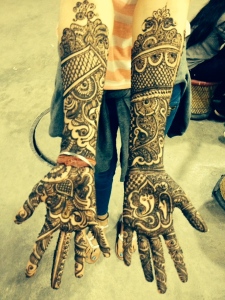Mehndi known as henna painting in the West and has long traditions in India. Mainly in connection with weddings, festivals and holidays. Indian brides are the most beautiful in the world. There is no limit to the amount of dill, dall and colors used to decorate themselves. The hands and feet are painted with the most beautiful patterns and it usually happens a couple of days before the wedding.

Leaves from a special bush are dried and ground into powder, this is mixed with oil/water and filled into a small container that is pierced with a thin needle in the bottom. This way you get a thin tip to shape the pattern with. The wet mass dries after about 30-40 minutes depending on the season and humidity. To keep the pattern moist, it is soaked with a mixture of sugar and lemon. If you can manage, the color will become stronger the longer you keep the mehndi moist. Brides often wear it overnight and the first thing you do the next morning is scrape off the dry mass and rub your hands and feet with mustard seed oil.


The color stays on the skin for a week, depending on how much you are in contact with water. Henna paint dries out the body and therefore moisture is added with oil, which also makes the skin shiny. The color can vary from deep orange to deep red when the paste is washed off. Basically, it is the individual woman's skin pigments that determine how strong the color will be, but in popular culture there is a myth that the stronger the love between the couple, the stronger the color.

(The pictures are from the previous Indian festival where my daughter got her mehndi)
The use of mehndi and turmeric in wedding ceremonies is described in the earliest Hindu Vedic scriptures (Veda comes from Sanskrit and the word means knowledge or to know. The four Vedic scriptures are based on traditions several thousand years old but took their current form around 1200 BC).
Haldi (a pre-wedding skin treatment with turmeric and oil, a jovial ceremony for both the bride and groom in their respective families) and Mehndi are Vedic customs and symbolize the outer and inner sun. Vedic customs are centered on the idea of "awakening the inner light" and in this case; preparing for marriage. Traditional Hindu patterns are sun patterns, flowers, peacock and parsley. You can also see several of these patterns in my cookbook and in the design of the products in my food series. Henna is also used to dye clothes, hair, leather, ponytails and animal fur.


(Image borrowed from Google)
